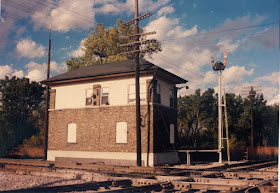Chicago and Northern Indiana Railroad Interlocking Towers (click the marker for more information)
Kevin Piper posted a history and some photos.
A summary of some comments by Wayne Hudak and Daniel Kopack on another Ken Durkel posting have some history of the junction and J line:
The B&O came through McCool in 1874. The J ended at McCool in 1888 and was finished to Porter in 1893. Originally, the Indiana portion of the J was to build from Valparaiso to the IL state line. They considered going to LaPorte.
Matt Lasayko Thanks for posting those pictures. When did that tower close?
Ken Durkel I think around 1964, at which time control of the interlocking was given over to the B&O dispatch in Akron.
 |
| Scott Griffith posted 1945 diamond at McCool IN. with the B&O. |
 |
| Ken Durkel commented on the above posting Looking west with McCool Road in the foreground. M.D. McCarter photo. Ken Durkel also posted McCool, Indiana. Now part of Portage. B&O/EJ&E crossing. Train is eastbound, McCool Road is the grade crossing. M.D. McCarter photo. |
 |
| Ken Durkel commented on the above posting |
The B&O came through McCool in 1874. The J ended at McCool in 1888 and was finished to Porter in 1893. Originally, the Indiana portion of the J was to build from Valparaiso to the IL state line. They considered going to LaPorte.
 |
| Ken Durkel commented on the above posting Another at McCool. Ken Durkel also posted McCool, Indiana. M.D. McCarter photo. Westbound B&O. |
 |
| Ken Durkel commented on the above posting And one more as a westbound moves across the EJ&E Porter Branch. Again an M.D. McCarter photo that I have. |
Ken Durkel I think around 1964, at which time control of the interlocking was given over to the B&O dispatch in Akron.










































